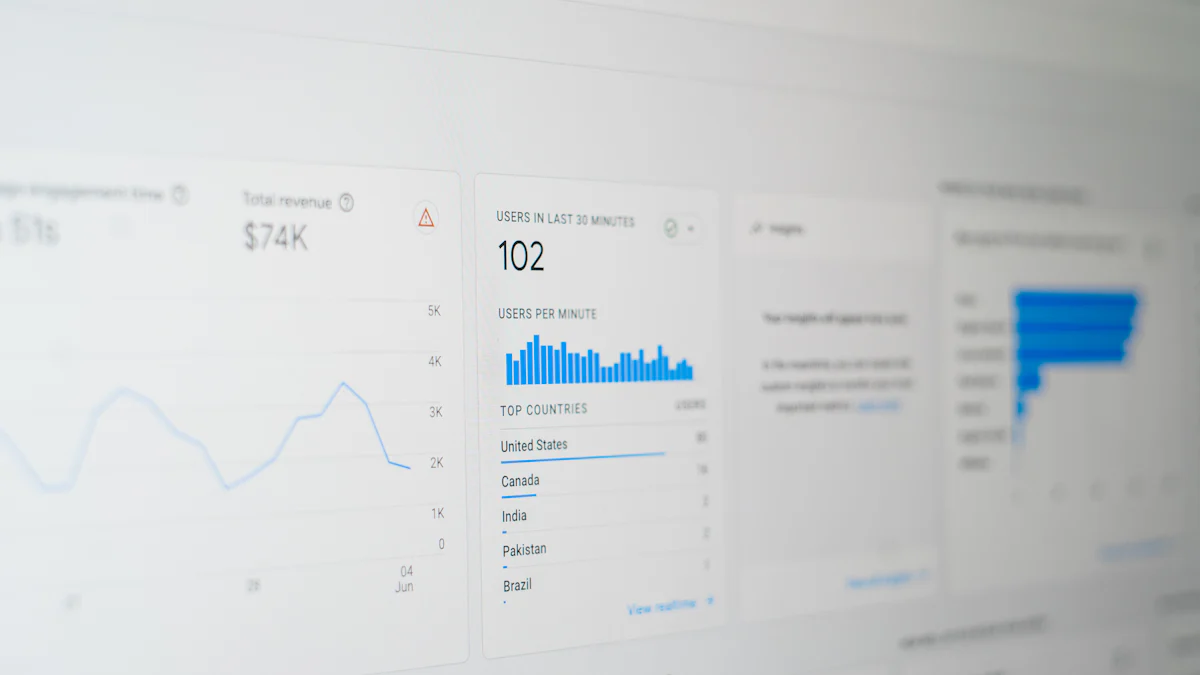5 Key Influencer Marketing Stats to Analyze Behavior

Have you ever wondered why some influencer campaigns seem to resonate more with consumers than others? It all comes down to understanding the right influencer marketing stats. Metrics like engagement rate, conversions, and audience demographics reveal how consumer behavior shifts when exposed to influencer content. For instance, visibility indicators like reach and impressions show how far your message travels, while engagement metrics like comments and shares highlight interest. By analyzing these stats, you can fine-tune your strategy to connect with your audience and drive meaningful results.
Engagement Rate: A Key Indicator of Consumer Interest

What Is Engagement Rate?
Engagement rate measures how actively people interact with content shared by social media influencers. It’s not just about likes or views; it’s about meaningful actions like comments, shares, and saves. These interactions show how much your audience connects with the influencer’s message. Think of it as a way to gauge how much influence the content has on your audience.
Different platforms have varying engagement rates. For example, YouTube tends to have the highest engagement rate at 8.2%, while TikTok sits at 0.9%. Here’s a quick breakdown:
| Platform | Engagement Rate |
|---|---|
| YouTube | 8.2% |
| 7.4% | |
| 2.9% | |
| 1.6% | |
| TikTok | 0.9% |
Understanding these numbers helps you choose the right platform for your strategy.
Why Engagement Rate Reflects Consumer Behavior
Engagement rate is like a window into consumer behavior. When people engage with content, it shows they’re interested, inspired, or even influenced by it. High engagement often means the influencer’s audience finds the content relatable or valuable. For example, if an influencer’s post about a product gets a lot of comments, it’s a sign that the audience is curious or considering a purchase.
This metric also reveals trust. Social media influencers with higher engagement rates often have stronger connections with their followers. That’s the power of social media influencers—they can spark conversations and build relationships that traditional ads can’t.
How to Measure and Improve Engagement Rate
To measure engagement rate, divide the total number of interactions (likes, comments, shares) by the total number of followers, then multiply by 100. For example, if an influencer has 10,000 followers and 500 interactions on a post, the engagement rate is 5%.
Boosting engagement starts with creating authentic, relatable content. Encourage influencers to ask questions, share personal stories, or use interactive features like polls. Collaborating with influencers whose values align with your brand also helps. When the audience feels a genuine connection, they’re more likely to engage.
Conversion Rate: Measuring Consumer Actions
What Is Conversion Rate in Influencer Marketing?
Conversion rate measures how many people take a desired action after interacting with an influencer’s content. These actions could include making purchases, signing up for a newsletter, or downloading an app. It’s one of the most important influencer marketing stats because it directly ties the influencer’s efforts to measurable results.
On average, conversion rates for influencer marketing campaigns range from 1% to 5%. However, the type of influencer and platform can make a big difference. For example:
- Instagram micro-influencers (10K-100K followers) see a conversion rate of 1.1%.
- Macro-influencers (100K-1M followers) average 0.7%.
- Bloggers with 10K-100K followers achieve a higher rate of 2.3%.
- TikTok micro-influencers hover around 0.8%.
These numbers show that smaller, niche audiences often convert better than massive followings.
Why Conversion Rate Is Crucial for Understanding Consumer Purchasing Behavior
Conversion rate gives you a clear picture of how well an influencer’s content drives consumer purchasing behavior. A high conversion rate means the audience isn’t just engaging with the content—they’re taking action. This metric helps you understand whether the influencer’s audience finds the product relevant and trustworthy.
Factors like audience relevance, trust, and the quality of the call-to-action (CTA) play a huge role in influencing conversions. For example:
- If the influencer’s followers align with your target audience, they’re more likely to act.
- A strong CTA, like “Shop now for 20% off,” can nudge hesitant consumers toward making a purchase.
By analyzing conversion rates, you can identify what’s working and refine your strategy to drive more results.
How to Track and Optimize Conversion Rate
Tracking conversion rate starts with setting clear goals. Are you aiming for purchases, sign-ups, or downloads? Once you know your goal, use tools like Google Analytics, affiliate links, or promo codes to measure results.
To optimize conversion rates, focus on these key areas:
- Audience Relevance: Partner with social media influencers whose followers match your target demographic.
- Content Quality: Ensure the influencer’s content feels authentic and aligns with your brand.
- CTA Effectiveness: Use clear, actionable CTAs that encourage immediate action.
- Offer Attractiveness: Provide discounts, free trials, or exclusive deals to make the offer irresistible.
Remember, even small tweaks can make a big difference. A more compelling CTA or a better-aligned influencer could significantly boost your conversions.
Audience Demographics: Aligning Influencers with Consumers

What Are Audience Demographics?
Audience demographics refer to the characteristics that define a group of people. These traits help you understand who the influencer’s followers are and whether they align with your target audience. Key demographic factors include:
- Location
- Age
- Gender
- Interests
- Values
- Religion
- Habits
- Ethnic background
- Sexual orientation
- Class
- Occupation
By analyzing these traits, you can determine if an influencer’s audience matches your brand’s ideal consumer. For example, if your product appeals to young adults in urban areas, you’ll want to partner with social media influencers whose followers fit that profile.
Why Audience Demographics Matter in Influencer Marketing
Understanding audience demographics is essential for creating successful influencer marketing campaigns. When an influencer’s audience aligns with your target market, your message resonates more effectively. This alignment boosts conversion rates and increases interest in your brand.
Think about it—if you’re promoting a fitness product, partnering with an influencer whose followers are fitness enthusiasts makes sense. On the other hand, if their audience is more interested in tech gadgets, your campaign might fall flat. Demographics like location, age, and interests play a huge role in shaping consumer behavior. Matching these traits ensures your campaign reaches the right people and drives meaningful results.
Tools to Analyze Audience Demographics
You don’t have to guess when it comes to audience demographics. Several tools can help you analyze an influencer’s audience and ensure they’re the right fit for your brand.
- Social media analytics platforms: Tools like Instagram Insights and TikTok Analytics provide data on follower demographics, including age, gender, and location.
- Influencer marketing platforms: Services like AspireIQ and Upfluence offer detailed audience reports, helping you find influencers whose followers match your target market.
- Third-party tools: Platforms like HypeAuditor and Social Blade analyze influencer profiles and provide insights into their audience’s habits and interests.
Using these tools, you can make data-driven decisions and maximize the impact of your influencer marketing campaigns.
Brand Mentions and Sentiment: Gauging Consumer Trust
What Are Brand Mentions and Sentiment?
Brand mentions refer to any time someone talks about your brand online, whether it’s in a social media post, a blog, or even a comment. These mentions can be direct, like tagging your brand, or indirect, like referencing your product without tagging. Sentiment, on the other hand, measures the tone of these mentions. Are people speaking positively, negatively, or neutrally about your brand? Together, these metrics give you a snapshot of how people perceive your brand and how much trust they place in it.
When social media influencers mention your brand, it’s a form of social proof. Their followers see these mentions as endorsements from a trusted source. If the sentiment is positive, it reinforces trust and authenticity, making your brand more appealing. Negative sentiment, however, can highlight areas for improvement. By tracking both mentions and sentiment, you can better understand consumer behavior and adjust your strategy accordingly.
How to Measure Brand Mentions and Sentiment
Measuring brand mentions and sentiment doesn’t have to be overwhelming. Several tools can help you track and analyze this data effectively. Here’s how you can get started:
- Use social listening tools to monitor mentions across platforms. These tools can segment mentions by keywords, sentiment, geography, or demographics, helping you focus on what matters most.
- Leverage sentiment analysis to categorize mentions as positive, negative, or neutral. This gives you a clear picture of how people feel about your brand.
- Track changes in the volume and sentiment of mentions over time. This helps you measure the effectiveness of your influencer marketing campaigns.
- Identify influencers who mention your brand. Their endorsements can boost your visibility and credibility.
- Dive deeper with advanced analytics platforms. These tools uncover hidden patterns in consumer behavior, giving you actionable insights.
By using these methods, you can stay on top of your brand’s reputation and make data-driven decisions.
Why These Metrics Reflect Consumer Trust and Perception
Brand mentions and sentiment are powerful indicators of trust and authenticity. When social media influencers talk about your brand, they lend their credibility to your message. Their followers view them as a trusted source, which makes their endorsements more impactful than traditional advertising. Positive mentions create social proof, showing potential customers that others trust your brand. This builds confidence and encourages them to engage with your products or services.
On the flip side, negative sentiment can reveal gaps in your strategy. Maybe your product didn’t meet expectations, or your messaging missed the mark. By addressing these issues, you can rebuild trust and improve your brand’s perception. Ultimately, tracking these metrics helps you understand how your influencer marketing efforts shape consumer behavior and trust.
ROI (Return on Investment): Evaluating Campaign Success
What Is ROI in Influencer Marketing?
ROI, or return on investment, measures how much value you gain from every dollar spent on your influencer marketing campaigns. It’s the ultimate way to see if your efforts are paying off. Unlike traditional marketing, influencer campaigns often deliver higher returns because they build trust and foster authentic relationships with consumers. On average, influencer marketing generates $5.78 for every $1 spent, while traditional marketing methods typically yield lower returns.
| Marketing Method | Average ROI |
|---|---|
| Influencer Marketing | $5.78 for every $1 spent |
| Traditional Marketing | Typically lower ROI |
This comparison highlights why ROI is such a critical metric. It shows you whether your investment in influencers is driving meaningful results or if adjustments are needed.
How to Calculate ROI for Influencer Campaigns
Calculating ROI might seem tricky, but it’s all about understanding your costs and returns. Start by defining your campaign goals. Are you aiming for sales, sign-ups, or app downloads? Once you know your goal, use this formula:
ROI = (Revenue Generated - Campaign Costs) / Campaign Costs x 100
For example, if your campaign costs $10,000 and generates $50,000 in revenue, your ROI is 400%.
However, challenges like attribution modeling and fraud detection can complicate things. Here are the most common hurdles:
- Defining goals and metrics to track success.
- Linking conversions to influencer efforts across multiple touchpoints.
- Detecting fake followers and engagement.
- Choosing influencers who align with your objectives.
- Accurately calculating ROI by considering all costs.
Overcoming these challenges requires clear planning, reliable tools, and a focus on building long-term relationships with influencers.
Why ROI Is the Ultimate Measure of Consumer Behavior Impact
ROI doesn’t just measure dollars—it reflects how well your campaigns influence consumer behavior. A high ROI shows that your audience trusts the influencer and finds their content compelling enough to take action. It also indicates that the relationships you’ve built with influencers are driving real results.
By focusing on ROI, you can identify which campaigns resonate most with your audience. This insight helps you refine your strategy and strengthen long-term relationships with influencers. When you invest in authentic partnerships, you’re not just boosting sales—you’re building trust and loyalty that lasts.
Understanding the five key influencer marketing stats—engagement rate, conversion rate, audience demographics, brand mentions and sentiment, and ROI—gives you a clear view of consumer behavior. These metrics help you identify what works, refine your campaigns, and build stronger connections with your audience. Always set clear KPIs, choose influencers carefully, and monitor for authentic engagement. Platforms like Instagram remain dominant, so consider experimenting with features like Stories. By tracking reach, impressions, and audience growth, you can create campaigns that deliver lasting results.
Remember, influencer marketing thrives on authenticity and strategy.
FAQ
What is the best way to choose the right influencer for my brand?
Look for influencers whose audience aligns with your target market. Check their engagement rate, content quality, and authenticity. Tools like AspireIQ or HypeAuditor can help you analyze their audience demographics and ensure they’re a good fit for your campaign.
How do I know if my influencer campaign is working?
Track key metrics like engagement rate, conversion rate, and ROI. Use tools like Google Analytics or promo codes to measure results. Positive brand mentions and sentiment also show that your campaign resonates with your audience.
Why is consumer behavior important in influencer marketing?
Understanding consumer behavior helps you predict how your audience will respond to influencer campaigns. It shows what motivates them to engage or purchase, allowing you to create more effective strategies that drive results.
Can smaller influencers deliver better results than big ones?
Yes! Micro-influencers often have more engaged and loyal audiences. Their followers trust their recommendations, which can lead to higher conversion rates. Smaller influencers also tend to feel more relatable, making their endorsements more authentic.
How can I improve my campaign’s ROI?
Set clear goals and track costs carefully. Partner with influencers who align with your brand and audience. Use strong calls-to-action and offer incentives like discounts. Authentic content and long-term influencer relationships also boost ROI.
See Also
5 Must-See Examples of Effective Influencer Marketing Briefs
Key Influencer Marketing Statistics to Enhance Your Strategies
20 Essential Influencer Marketing Statistics Every Marketer Should Know
Comprehending the Return on Investment in Influencer Marketing
15 Essential Influencer Marketing Platforms for 2024 Success
